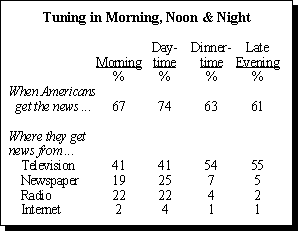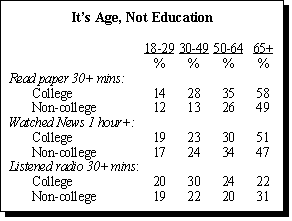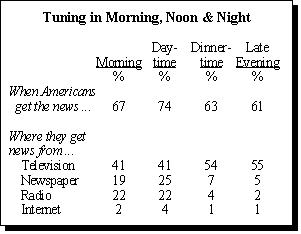The average American dedicates more than an hour a day to the news. More Americans read, watch or listen to the news each day than exercise or use a personal computer. Indeed, daily consumption of news appears thin only when compared to personal activities such as family meals and calling friends or relatives to talk.
 This portrait of time, however, masks wide variation in news consumption patterns among people of different generations, genders, races and education levels. Among these, age is by far the greatest factor affecting Americans’ attention to the news. The generational differences are most evident at the extremes. Fully 25% of all 18-24 year-olds did not read, watch or listen to any news yesterday; only 6% of those age 65 and older were similarly tuned out.
This portrait of time, however, masks wide variation in news consumption patterns among people of different generations, genders, races and education levels. Among these, age is by far the greatest factor affecting Americans’ attention to the news. The generational differences are most evident at the extremes. Fully 25% of all 18-24 year-olds did not read, watch or listen to any news yesterday; only 6% of those age 65 and older were similarly tuned out.
Although gaps between the different age groups are evident for all media, they are greatest for daily newspapers. Only 26% of 18-24 year-olds report reading the paper yesterday. The average 18-24 year-old spent only nine minutes doing so. In contrast, 69% of those 65 and older read the paper yesterday, spending an average of 33 minutes on the task.
The generational differences that are present in newspaper reading habits are not as sharp for television news viewing and non-existent for radio. The youngest age group is less likely to watch television news than is the oldest, spending an average of 26 minutes on all TV news to seniors’ 44 minutes. Those under age 30 spent 15 minutes listening to radio news, compared to 19 minutes for those over age 65.
Young adults’ relatively greater interest in television over newspapers is not simply a preference for watching over reading. Magazines are very popular among this age group. Americans ages 18-24 are most likely to have read a magazine yesterday and most likely to have devoted a considerable amount of time to it. Their consumption of magazines is especially striking when compared to their newspaper reading habits. Fully 42% of this age group read a magazine the day before the interview — significantly more than the 26% who read a paper that day. In addition, the average 18-24 year old spent 17 minutes reading a magazine yesterday — almost twice the time they spent reading the newspaper.
Finally, young people are the most enthusiastic users of the newest media — online services. Fully 38% of Americans under age 30 went online yesterday, outpacing the number who read the paper during this same time period. This strong showing is fueled in part by the enthusiasm of young men, who are slightly more likely to go online than are young women: 40% of men between ages 18 and 29 went online yesterday, compared to 34% of women in this same age group.
 Age is more important than even education in understanding media use among the public. Not surprisingly, college-educated Americans spend more time reading newspapers and magazines than do those whose education ended with high school. However, the gaps in the amount of time that an individual dedicates to the news are much greater among different age groups than between those who have some college experience and those without any at all.
Age is more important than even education in understanding media use among the public. Not surprisingly, college-educated Americans spend more time reading newspapers and magazines than do those whose education ended with high school. However, the gaps in the amount of time that an individual dedicates to the news are much greater among different age groups than between those who have some college experience and those without any at all.
The only exception to this tendency involves going online. The gap between those who went online yesterday and those who did not is greater between the college educated and non-college educated than between the young and old. Almost half (49%) of 18-29 year-olds with at least some college education report going online yesterday, compared to 29% of young people with no college education, 35% of 50-64 year-olds with some college experience and 11% of middle-aged Americans without it.
Daylong News
 On a typical day, a solid majority of Americans are reading the newspaper, watching television news, listening to radio news or logging onto the Internet from the beginning of the day until the late night hours. Midday is the most common time to get the news. The medium of choice is always television.
On a typical day, a solid majority of Americans are reading the newspaper, watching television news, listening to radio news or logging onto the Internet from the beginning of the day until the late night hours. Midday is the most common time to get the news. The medium of choice is always television.
Two-thirds of Americans start their day with some kind of news. This audience is heavily oriented toward television: 41% of Americans watch television news in the morning; 22% turn on the radio; 19% read a newspaper.
News consumption peaks in the middle of the day: 74% of the public reads, watches or listens to the news during the course of the day. Television continues to be the biggest draw: 41% of the public gets daytime news from television, the same percentage who report tuning in for morning news. Newspapers are slightly more popular in the middle of the day than in the earlier hours: 25% of the public reads a paper during the day. Radio consumption remains steady (22%) throughout the workday.
Dinner time and late night news consumption are slightly less popular and almost entirely television based. Regardless of sex, age, race or education, whether one is a regular newspaper reader, a cable subscriber or an online user, the overwhelming majority of people who get news at the dinner hour or late in the evening get it from television.
Daytime News Habits Differ
Men and women differ only in their choice of daytime news media, not in their general consumption habits. More women watch television news during the day; more men listen to the radio. Almost half (47%) of all women turn on television news mid-day, compared to 34% of men. Over a quarter (27%) of men listen to radio news during the day, compared to 18% of women.
Men and women do not differ in their morning or late night routines. Both start and end the day with the news at equivalent rates and are equally likely to choose television over the radio and the newspaper. Similarly, there are no significant gender differences in the rates at which these different groups get news throughout the day.
Age Gap Disappears for Late Night News
Since young adults are less interested in news, they are less likely to start their day with news. Only 56% of 18-29 year olds report starting a typical day with the news, compared to 71% of those age 30 and over. This disparity in news interest lessens over the course of the day until late evening, when it disappears entirely. Fully 60% of 18-29 year olds, 60% of 30-49 year olds and 62% of those age 50 and over get news during the late evening hours. An overwhelming majority (81%) of Americans between ages 30 and 49 who are married and have children get news during the course of the day.
Use of the Internet for news is highest at midday. Of those who go online on a weekly basis, 9% say that their main source of news during the daytime is the Internet.
Clickers vs. Tune-Iners
The American public is more focused when they are watching television generally than when they are tuning in to television news. When most Americans (62%) turn on the television, they do so to catch a specific program, rather than to channel surf, a trend that has not changed over the past four years. However, 56% of Americans watch the news with their remote control in hand, switching channels when they are not interested in the topic.
Americans who do not watch television news with a remote control watch more of it than do those who click around. Almost two-thirds (64%) of “tune-iners” watched the news the day before their interview, compared to 56% of clickers.
In addition, Americans who are deliberate in their news viewing habits are more attentive to the news than are those who channel surf. One-third (35%) of those who do not roam spent an hour watching the news yesterday; only 19% of clickers spent this much time.
Young adults show a propensity to channel surf, while older Americans retain habits formed in the pre-remote control days. While almost three-quarters of 18-24 year olds watch the news with a remote, less than half of those age 65 and over do. Young men appear least focused on the news and most likely to channel surf. Fully 72% of men ages 18-29 watch the news with their remotes in hand, compared to 66% of women in this age group and 56% of the general public.
With more choices available, cable subscribers are more likely to watch the news using a remote than are non-cable subscribers.


